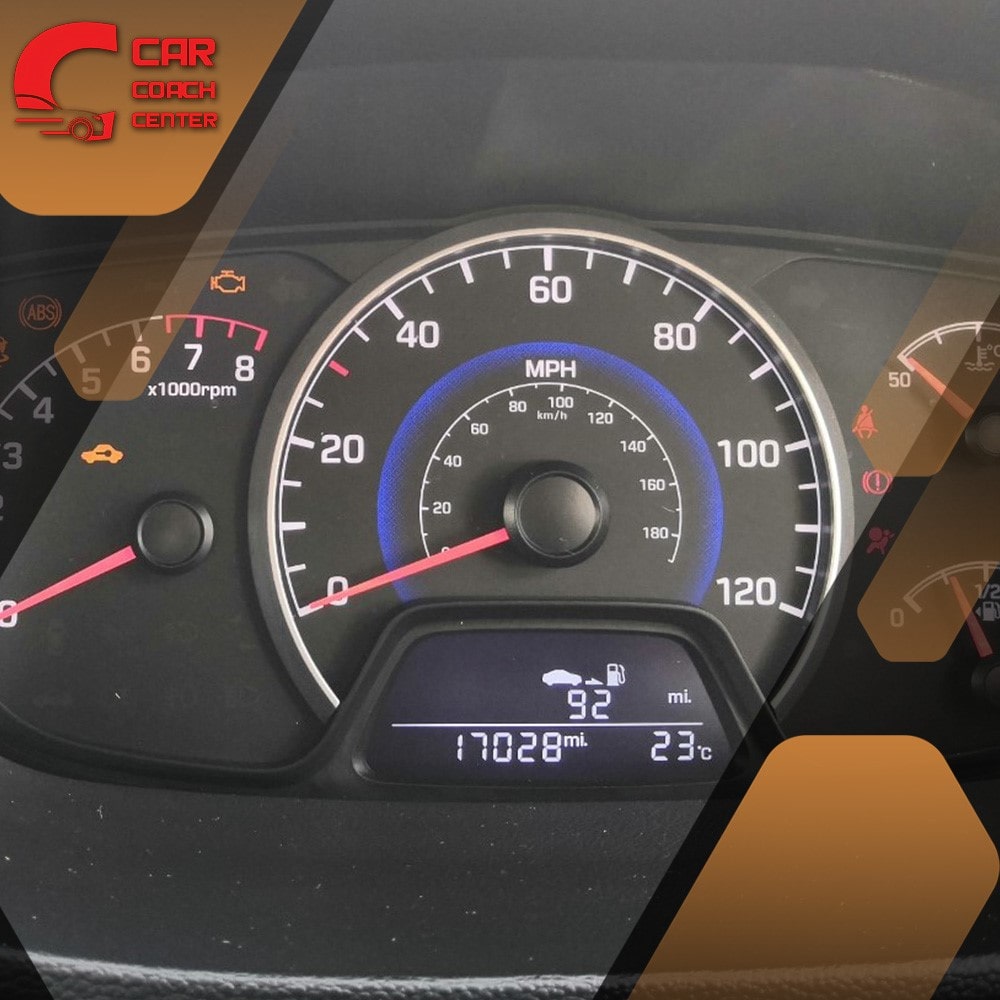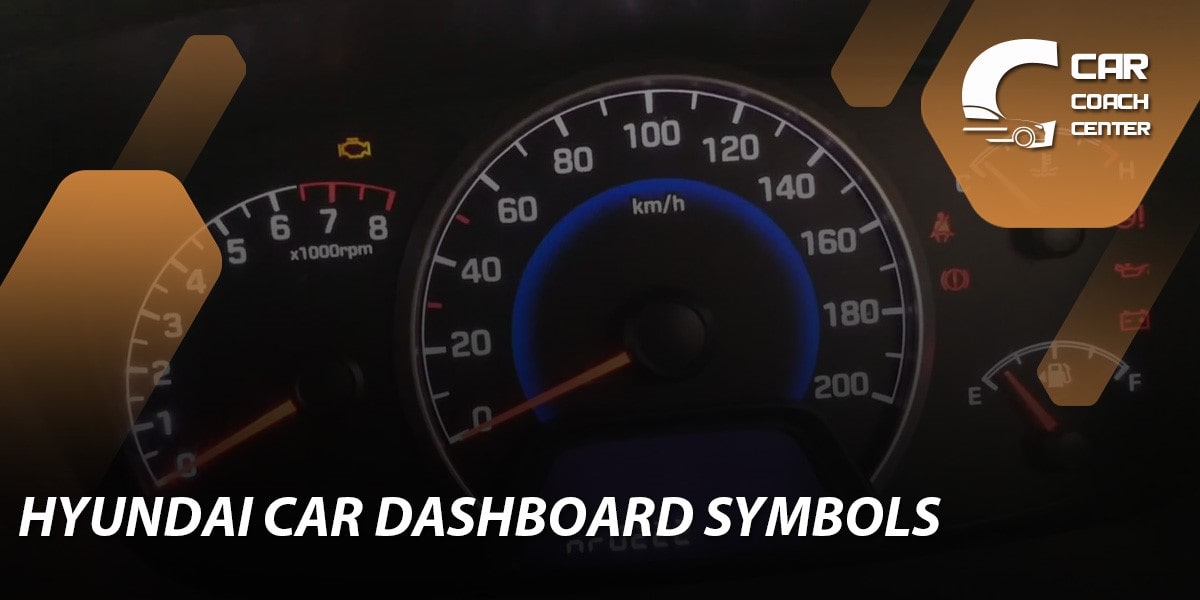
Deciphering your Hyundai i10 car dashboard symbols and meanings can be akin to solving an intriguing puzzle. As a vigilant driver, understanding these cryptic icons is vital for maintaining your car’s health and ensuring a safe journey on the road. From the moment you start your engine, the dashboard symbols come to life, relaying crucial information about various vehicle functions and potential issues.
In this comprehensive guide, we shed light on the enigmatic world of Hyundai i10 dashboard symbols and warning lights, empowering you with the knowledge to interpret these visual cues like a pro. Whether it’s a glowing exclamation mark, a mysterious engine-shaped light, or any other symbol that appears, we’ve got you covered.
Prepare to embark on a journey of discovery, as we unlock the meanings behind the Hyundai i10 dashboard symbols, equipping you with the tools to maintain your vehicle’s peak performance and navigate any automotive challenge with confidence. Let’s unravel the mysteries together and embark on a dashboard enlightenment adventure!
Decoding the Enigmatic Icons: A Guide to Understanding Hyundai i10’s Dashboard Symbols
When you slip behind the wheel of your Hyundai i10, you are greeted by a cluster of dashboard symbols, each with its unique shape and meaning. Understanding these symbols is essential for staying informed about your car’s condition and identifying potential issues before they escalate. From the familiar icons like the seatbelt reminder and fuel indicator to the more enigmatic warning lights, such as the check engine light and ABS (Anti-lock Braking System) symbol, each plays a crucial role in relaying information about your vehicle.
One of the most common dashboard symbols is the check engine light, often depicted as an engine-shaped icon. When this light illuminates, it signals that the car’s onboard diagnostic system has detected a potential problem with the engine or emissions system. It is crucial not to ignore this warning, as it could indicate anything from a loose gas cap to a more serious mechanical issue.
Another essential symbol is the battery warning light, usually represented by a small battery icon. This light indicates that there might be a problem with your car’s charging system and the battery is not receiving sufficient charge from the alternator. Ignoring this warning could lead to a drained battery and a stranded vehicle.
The ABS warning light, featuring the letters “ABS” inside a circle, notifies you of an issue with your Anti-lock Braking System. If this light remains lit, it signifies a potential problem with your vehicle’s braking system, which could compromise your ability to brake safely in certain situations.
Additionally, your Hyundai i10’s dashboard might display symbols related to the airbag system, tire pressure, traction control, and more. Familiarizing yourself with these symbols will enable you to act promptly and appropriately if any warning lights appear.
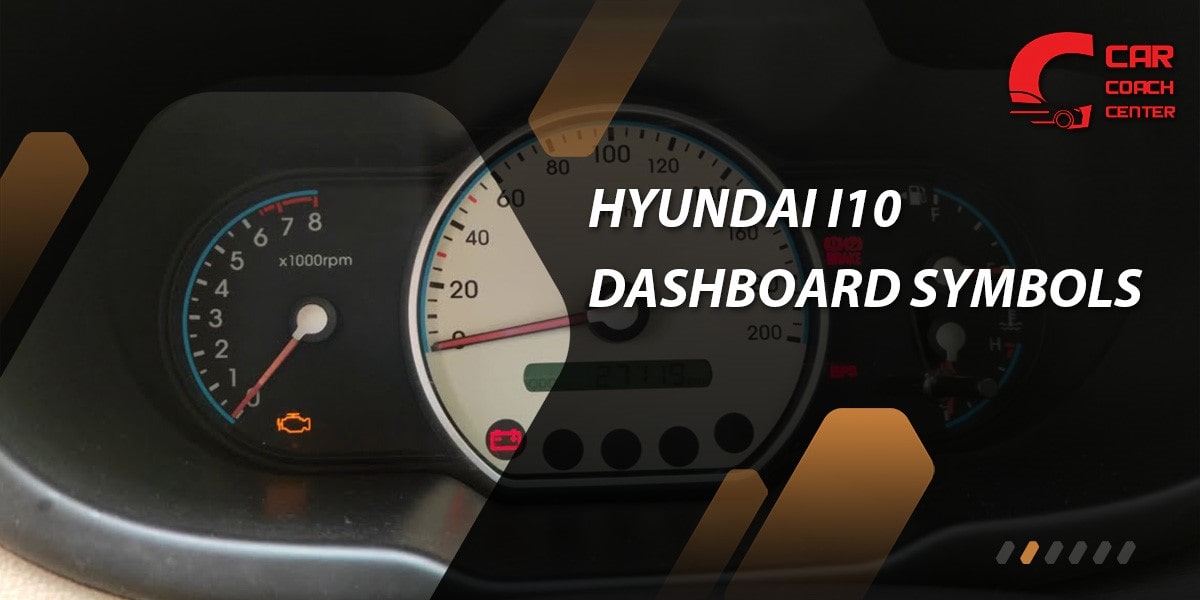
From A to Z: A Comprehensive Dictionary of Hyundai i10 car dashboard symbols and meanings
Navigating the array of dashboard symbols in your Hyundai i10 can sometimes feel like interpreting a complex language. We present a comprehensive A-to-Z dictionary of Hyundai i10 dashboard symbols and warning lights to equip you with the necessary knowledge. Let’s delve into this essential guide and decode the meanings behind these enigmatic icons:
Airbag Indicator
Represented by a person with a deployed airbag in front, this light indicates an issue with the airbag system. If this light stays on or flashes, have your vehicle checked by a professional immediately.
Battery Warning
Depicted as a small battery icon, this light warns of a potential problem with your car’s charging system. Check your battery connections and charging system to see if it remains illuminated.
Check Engine Light
The engine-shaped icon indicates an engine or emissions system issue. Seek professional diagnostics to identify the problem.
Door Ajar
Displayed as an open car with an open door, this light informs you if any doors are closed properly.
Electronic Stability Control (ESC) Indicator
The symbol of a car with swerving lines behind it indicates a problem with the ESC system. Get it checked to ensure proper vehicle stability.
Fuel Indicator
This symbol resembles a gas pump, alerting you when your fuel level is low. Refuel promptly to avoid running out of gas.
Glow Plug Indicator (Diesel models)
Only in diesel models, this light indicate that the engine’s glow plugs are warming up before starting.
High Beam Indicator
Shaped like a headlight with beams, it reminds you when high beams are engaged.
Indicator Lights
This icon appears as an “i” inside a circle, warning you of issues like low washer fluid, burned-out bulbs, or maintenance reminders.
Fog Lamp Indicator
When activated, this light shows a front light beam with wavy lines, indicating the fog lamps are in use.
Keyless Entry Warning
Shown as a car with a key inside, it indicates a problem with the keyless entry system.
Low Tire Pressure
The symbol of a deflated tire informs you when tire pressure is low, potentially affecting your vehicle’s performance.

– Malfunction Indicator Lamp (MIL)
The “Check Engine Light” signals a potential problem with your engine or emissions system.
Neutral Indicator
This symbol, usually an “N,” indicates that your vehicle’s gear is neutral.
Oil Pressure Warning
Represented as an oil can, this light warns you if your engine’s oil pressure is too low.
Parking Brake Indicator
Depicted as a “P” inside a circle, it reminds you when the parking brake is engaged.
Quality of Air Warning
This symbol indicates poor air quality inside the car. Check your air circulation settings.
Rear Fog Lamp Indicator
Shown as a rear light beam with wavy lines, it indicates the rear fog lamps are in use.
Seatbelt Reminder
The symbol of a person wearing a seatbelt reminds you and your passengers to buckle up.
Trunk Open Warning
Displayed as an open car with an open trunk, it alerts you if your trunk is not closed securely.
Update Required Reminder
The letter “U” inside a circle indicates that your vehicle’s Software needs updating.
Vehicle Stability Management (VSM) Indicator
The symbol of a car with wavy lines behind it warns of an issue with the VSM system.
Washer Fluid Low
This icon, resembling a windshield with water spray, reminds you to refill your washer fluid.
All-Wheel Drive (AWD) Indicator
Only applicable to AWD models; this light indicates when the AWD system is engaged.
Yield Indicator
This symbol, usually a “Y,” reminds you to yield to other vehicles or pedestrians.
Turn Signal Indicator
Represented as arrows pointing left and right, it blinks when you activate the turn signals.
When the Dashboard Talks: How to Interpret Your Hyundai i10’s Warning Lights
Your Hyundai i10’s dashboard is equipped with an advanced system that communicates with you through a series of warning lights, each designed to alert you to potential issues with your vehicle. Understanding these warning lights is crucial for promptly addressing any problems and ensuring your safety on the road. Let’s explore some of the most common Hyundai i10 warning lights and their meanings, empowering you to interpret your dashboard’s messages effectively.
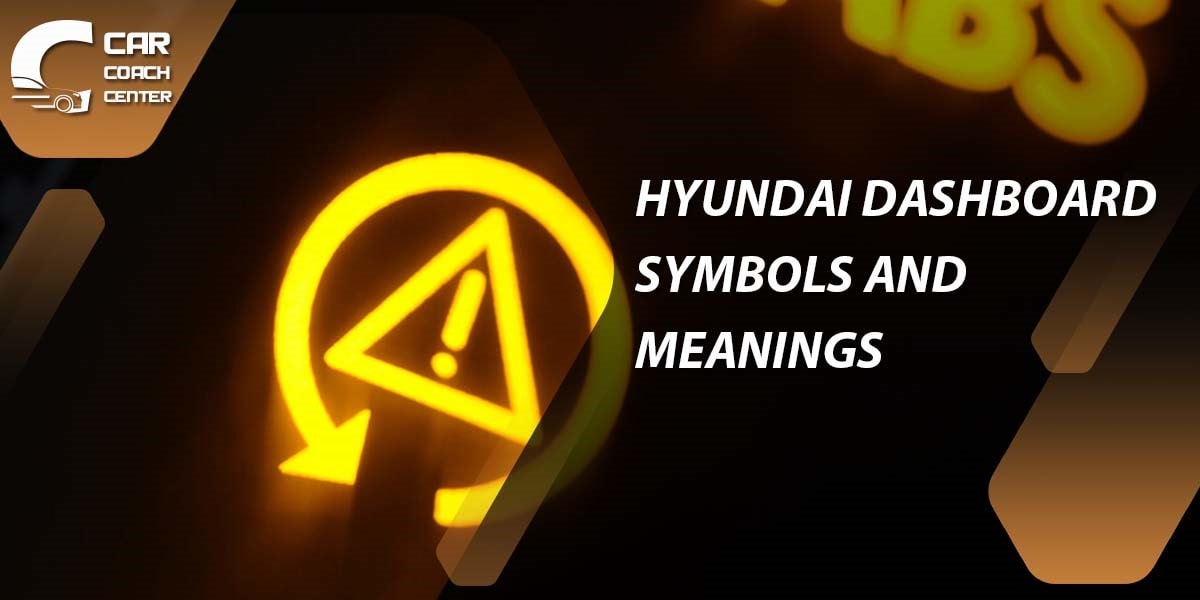
Check Engine Light (MIL)
Among the most well-known warning lights, the check engine light, represented by an engine-shaped icon, signifies a potential problem with your engine or emissions system. While it may illuminate minor issues, such as a loose gas cap, it could also indicate more serious engine problems. When this light appears, it’s essential to schedule a visit to a certified mechanic for a thorough diagnostic check.
Battery Warning
Depicted as a small battery icon, this light warns you of an issue with your car’s charging system. It could indicate a faulty alternator, a loose belt, or a worn-out battery. Ignoring this warning might lead to a dead battery and a stranded vehicle. Have your vehicle’s charging system inspected by a professional immediately.
ABS Warning Light
The ABS warning light, featuring the letters “ABS” inside a circle, informs you of a potential issue with your Anti-lock Braking System. If this light stays illuminated, it suggests a problem with your vehicle’s braking system. In such situations, braking performance might be affected, especially during emergency stops. Promptly have your braking system checked by a qualified technician.
Airbag Indicator
Shaped like a person with a deployed airbag in front, this light indicates a malfunction in your vehicle’s airbag system. When this light is on, it implies that the airbags might not deploy correctly in a collision. Given airbags’ critical role in protecting occupants during accidents, seek immediate professional attention if this light remains illuminated.
Tire Pressure Warning
Represented by a deflated tire, this light alerts you when the tire pressure in one or more of your tires is low. Improper tire pressure can affect handling, fuel efficiency, and tire longevity. Check and adjust your tire pressures accordingly, and if the light persists, inspect your tires for punctures or leaks.
Oil Pressure Warning
This warning light, usually depicted as an oil can, notifies you when your engine’s oil pressure is too low. Low oil pressure could lead to engine damage if not addressed promptly. Stop your vehicle in a safe location, turn off the engine, and check the oil level. Contact a mechanic to diagnose and rectify the oil pressure issue if sufficient.
Beyond the Basics: Lesser-Known Hyundai i10 Dashboard Icons Unveiled
While many Hyundai i10 drivers are familiar with common dashboard symbols like the check engine light and battery warning, several lesser-known icons also play essential roles in keeping your vehicle running smoothly. Understanding these overlooked dashboard symbols can help avoid potential issues and ensure a seamless driving experience. Let’s shed light on some of the lesser-known Hyundai i10 dashboard icons and their meanings:
Electronic Stability Control (ESC) Indicator
Depicted as a car with swerving lines behind it, this light indicates a potential problem with your vehicle’s Electronic Stability Control system. The ESC system helps maintain control during sudden maneuvers and slippery road conditions. If this light illuminates, it’s essential to have your ESC system checked by a professional to ensure optimal handling and stability.
Vehicle Stability Management (VSM) Indicator
Shown as a car with wavy lines behind it, this warning light informs you of an issue with the Vehicle Stability Management system. VSM works with the ESC system to enhance stability and steering control. If this light remains on, inspect your VSM system to maintain safe driving conditions.
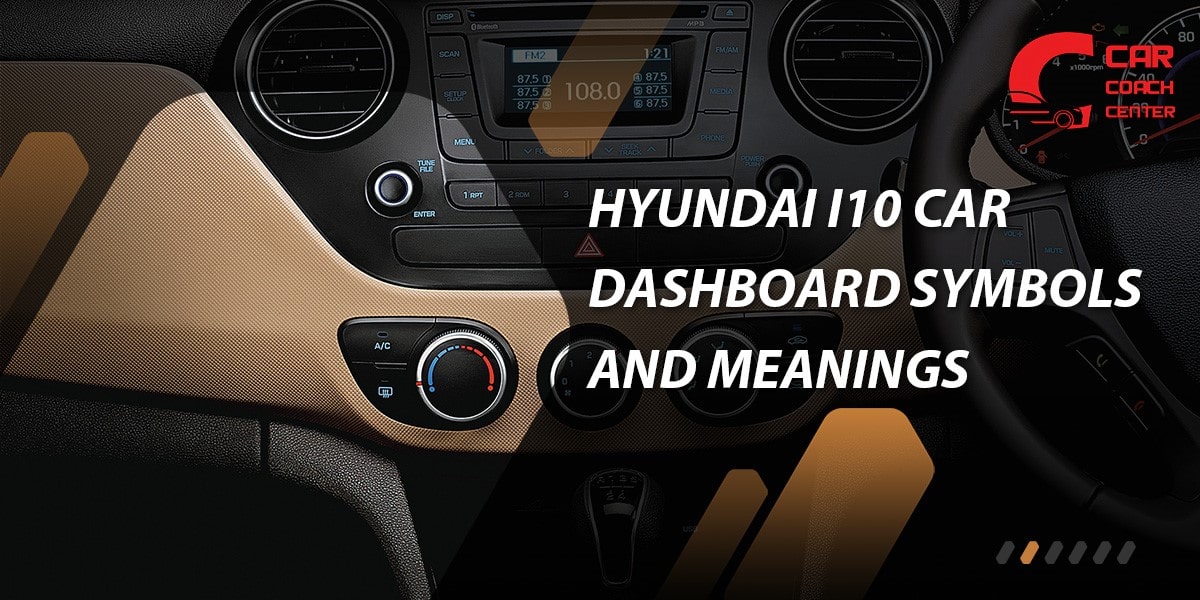
Glow Plug Indicator (Diesel models)
Exclusive to diesel models, this icon indicates that the engine’s glow plugs are warming up before starting the engine. When you see this light, wait for it to turn off before starting your car. The glow plugs to ensure proper ignition in diesel engines, especially in colder temperatures.
All-Wheel Drive (AWD) Indicator
Applicable only to AWD models, this light signals when the All-Wheel Drive system is engaged. AWD enhances traction on slippery roads by distributing power to all wheels. When this light appears, your AWD system is actively helping you maintain better control during challenging driving conditions.
Quality of Air Warning
Displayed as an exclamation mark inside a car, this symbol indicates poor air quality. Check your air circulation settings and ensure the cabin air filter is clean and functioning correctly to improve air quality.
Update Required Reminder
When you see the letter “U” inside a circle, it indicates that your Hyundai i10’s Software requires updating. Keeping your vehicle’s Software up to date ensures optimal performance and may address known issues or enhance features.
Cracking the Code: What Your Hyundai i10’s Dashboard Symbols Say About Your Car’s Health
Your Hyundai i10’s dashboard is a sophisticated communication center, relaying vital information about your car’s health through a series of dashboard symbols and warning lights. Understanding these visual cues is key to identifying potential issues and taking proactive measures to maintain your vehicle’s peak performance. Let’s crack the code and unveil what your Hyundai i10’s dashboard symbols are telling you about your car’s health:
Check Engine Light (MIL)
As one of the most critical warning lights, the check engine light, represented by an engine-shaped icon, demands immediate attention. When this light appears, it signals a potential problem with your engine or emissions system. Though it could indicate minor issues like a loose gas cap, it may also point to more serious engine problems. Ignoring the check engine light may reduce fuel efficiency, increase emissions, or even damage. Have your vehicle inspected by a qualified technician to diagnose and address the issue promptly.
Battery Warning
Depicted as a small battery icon, this warning light alerts you to a potential car charging system problem. A faulty alternator, loose belt, or worn-out battery could be the culprit. If this light stays on, it’s crucial to have your vehicle’s charging system checked, as a depleted battery might leave you stranded. Taking prompt action can prevent further complications and keep your car running smoothly.
Oil Pressure Warning
Represented by an oil can, the oil pressure warning light indicates that your engine’s oil pressure is too low. Low oil pressure could result from insufficient oil levels or oil pump or filter issues. Driving with low oil pressure can lead to engine damage, so it’s vital to stop your vehicle immediately, check the oil level, and top it up if necessary. If the light persists, seek professional assistance to diagnose and resolve the issue.
Tire Pressure Warning
Depicted as a deflated tire, this warning light notifies you when tire pressure is low in one or more tires. Incorrect tire pressure can affect your car’s handling, fuel efficiency, and tire longevity. Check and adjust your tire pressures to the recommended levels, ensuring a safer and more comfortable ride.
ABS Warning Light
The Anti-lock Braking System (ABS) warning light, featuring the letters “ABS” inside a circle, informs you of a potential issue with your vehicle’s braking system. If this light remains illuminated, it suggests a problem with your brakes, and the ABS may not function correctly during sudden stops or slippery road conditions. Have a professional inspect your braking system to ensure optimal safety on the road.
Airbag Indicator
Shaped like a person with a deployed airbag in front, this warning light indicates a malfunction in your vehicle’s system. If the airbag light stays on, it implies that the airbags might not deploy effectively during a collision, compromising passenger safety. Seek immediate professional attention to diagnose and resolve the airbag system issue.
Dashboard Zen: Tips for Keeping Your Hyundai i10 Dashboard Symbol-Free
A clutter-free dashboard with no warning lights illuminating is every Hyundai i10 owner’s dream. Keeping your dashboard symbol-free ensures a stress-free driving experience and indicates that your vehicle is in excellent condition. Here are some essential tips to achieve dashboard zen and minimize the appearance of Hyundai i10 dashboard symbols and warning lights:
Regular Maintenance Checks
Staying on top of your Hyundai i10’s maintenance schedule is crucial to prevent unexpected issues that might trigger warning lights. Follow the manufacturer’s recommended maintenance intervals for oil changes, filter replacements, and other scheduled services. Regular maintenance helps keep your car in top shape and minimizes the chances of dashboard symbols appearing.
Check Fluid Levels
Routinely check essential fluid levels in your Hyundai i10, such as engine oil, coolant, brake fluid, and windshield washer fluid. Low fluid levels can trigger warning lights, and neglecting them may lead to more severe problems. Always ensure your fluids are at optimal levels to maintain optimal vehicle performance.
Inspect Your Tires
Proper tire maintenance is essential for safety and efficiency. Regularly check tire pressure and inspect for signs of wear or damage. Underinflated or damaged tires may activate the tire pressure warning light, impacting your car’s handling and fuel economy.
Secure the Gas Cap
A loose or improperly secured gas cap can trigger the check engine light. After refueling, tighten the gas cap until you hear a clicking sound. This simple step can prevent the check engine light from coming on unnecessarily.
Drive Sensibly
Aggressive driving habits, such as rapid acceleration, hard braking, and excessive speeding, can strain your Hyundai i10’s systems unnecessarily. It can also lead to issues that trigger warning lights, especially the check engine light. Adopt a smooth and sensible driving style to reduce wear and tear on your vehicle.
Address Warning Lights Promptly
If a dashboard symbol or warning light does appear, don’t ignore it. Take prompt action by consulting your Hyundai i10 owner’s manual to identify the warning and recommended steps. In some cases, the issue may be minor and easily resolved. However, if the light indicates a more serious problem, seek professional assistance to prevent further damage.
Keep Software Updated
Modern vehicles, including the Hyundai i10, often have software updates to improve performance, address known issues, and enhance features. Regularly check for software updates provided by Hyundai and have them installed by a qualified technician to ensure your vehicle operates optimally.
Conclusion
In conclusion, understanding the language of your Hyundai i10’s dashboard symbols and warning lights is a vital skill that empowers you to be a more responsible and informed driver. By deciphering these enigmatic icons, you gain valuable insights into your car’s health, enabling you to address potential issues proactively and maintain a symbol-free dashboard.
Regular maintenance, diligent fluid level checks, and attentive driving contribute to a harmonious driving experience, ensuring your Hyundai i10 operates at its best. As you embark on this dashboard enlightenment journey, remember to refer to the comprehensive dictionary of dashboard symbols, uncovering the meanings behind each icon. Embracing dashboard zen enhances your safety and extends the longevity of your beloved Hyundai i10.
For further automotive guidance and expert tips, visit the CarCouchCenter.com website, where knowledge awaits to support your adventure. Drive confidently, and may your dashboard always reflect a clear path ahead!
Frequent Questions
What does the check engine light in my Hyundai i10 indicate?
The check engine light signals potential engine or emissions system issues. It requires immediate attention and professional diagnosis.
Why is my Hyundai i10's battery warning light on?
The battery warning light indicates a problem with your car's charging system, such as a faulty alternator or a worn-out battery.
How can I interpret the airbag warning light in my Hyundai i10?
The airbag warning light suggests a malfunction in the airbag system. It requires immediate inspection by a professional for passenger safety.

